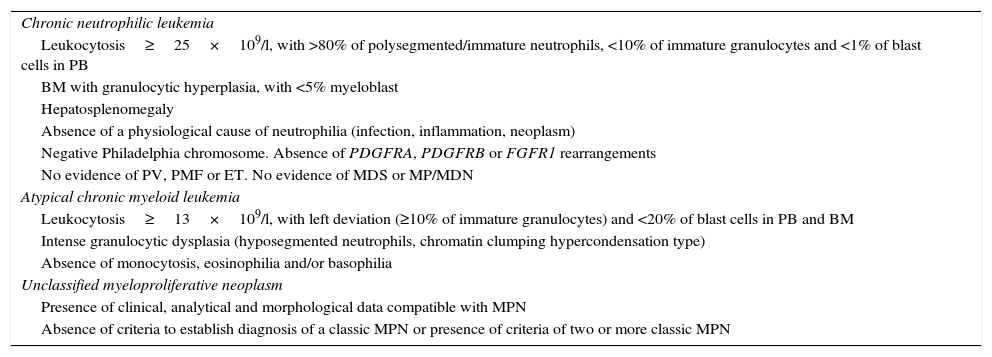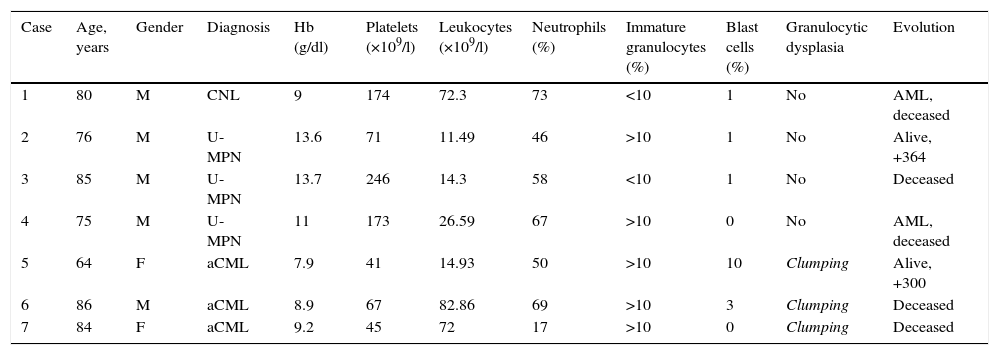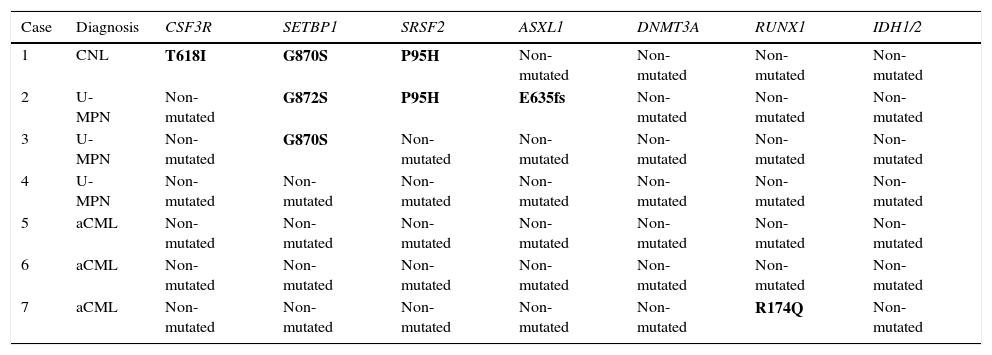Atypical chronic myeloid leukemia (aCML) and chronic neutrophilic leukemia (CNL) display similar clinical and haematological characteristics. The objective of the present study was to determine the mutational status of SETBP1 and CSF3R in these diseases.
Patients and methodThe mutational status of SETBP1 and CSF3R was studied in 7 patients with aCML (n=3), CNL (n=1) and unclassifiable myeloproliferative neoplasms (MPN-u) (n=3). Additionally, mutations in ASXL1, SRSF2, IDH1/2, DNMT3A, and RUNX1 were also analysed.
ResultsSETBP1 mutations (G870S and G872R) were detected in 2 patients with MPN-u, and one of them also presented mutations in SRSF2 (P95H) and ASXL1 (E635fs). The CNL case showed mutations in CSFR3 (T618I), SETBP1 (G870S) and SRSF2 (P95H). No patient classified as aCML had mutations in SETBP1 or CSF3R. One of the patients with mutations evolved to acute myeloid leukemia, while the other 2 had disease progression without transformation to overt leukemia.
ConclusionThe knowledge of the molecular alterations involved in these rare diseases is useful in the diagnosis and may have an impact on both prognosis and therapy.
La leucemia mieloide crónica atípica (LMCa) y la leucemia neutrofílica crónica (LNC) presentan gran similitud clínico-analítica. El objetivo del estudio fue determinar el estado mutacional de SETBP1 y CSF3R en dichas entidades.
Pacientes y métodoSe analizó el estado mutacional de SETBP1 y CSF3R en 7 pacientes con LMCa (n=3), LNC (n=1) y neoplasia mieloproliferativa (NMP) inclasificable (n=3). Adicionalmente se estudiaron los genes ASXL1, SRSF2, IDH1/2, DNMT3A y RUNX1.
ResultadosSe detectaron mutaciones en SETBP1 (G870S y G872R) en 2 pacientes con NMP inclasificable; uno de ellos presentó, además, mutaciones en SRSF2 (P95H) y ASXL1 (E635fs). El paciente afectado de LNC presentó mutaciones en CSFR3 (T618I), SETBP1 (G870S) y SRSF2 (P95H). Ningún paciente catalogado como LMCa mostró mutación de SETBP1 o CSF3R. De los pacientes con mutaciones, uno evolucionó a leucemia aguda mieloblástica y 2 presentaron progresión de la enfermedad sin llegar a documentarse transformación a leucemia.
ConclusiónEl conocimiento de las alteraciones moleculares involucradas en estas raras enfermedades es útil en el diagnóstico y podría tener repercusión tanto en el pronóstico como en el tratamiento.
Artículo
Comprando el artículo el PDF del mismo podrá ser descargado
Precio 19,34 €
Comprar ahora









